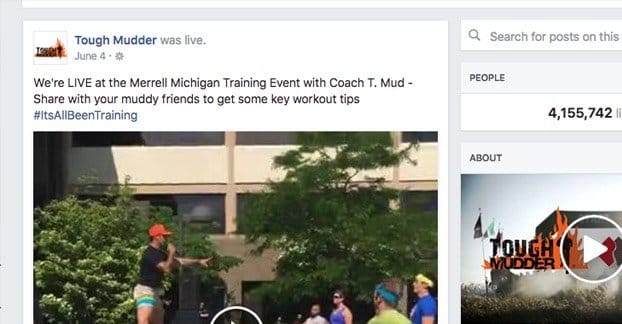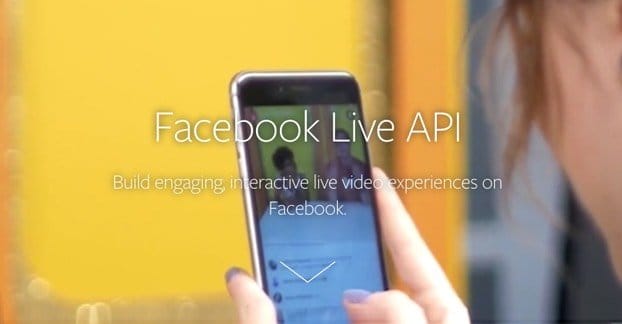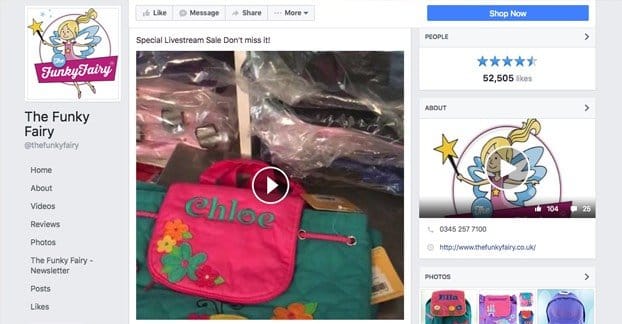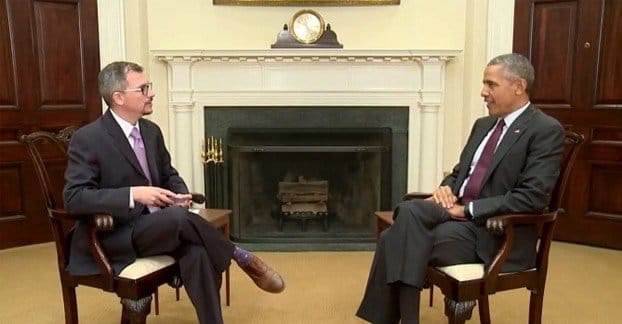 Written by ContentPowered.com
Written by ContentPowered.com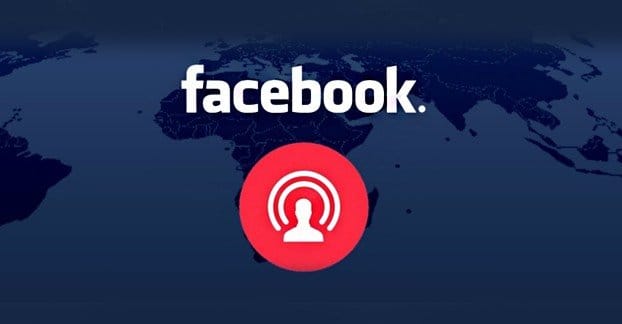
Facebook live streaming, also known as Facebook Live Video, is a new offering from Facebook that hit brands not that long ago. It’s only been a little while, but already, we’re seeing brands making use of it for marketing purposes.
Facebook live video comes about as a competitor to other big name streaming services, like Twitch.tv, Hitbox.tv, Periscope, and YouTube Live. It’s designed for pages, not for personal profiles, so it’s clearly made as a marketing tool. However, it’s made to function with the Android and iOS apps, and users of Facebook Mentions.
If you haven’t seen a Facebook Live video in action, it’s a pretty interesting experience. It shows up in your feed just like any other video or post, complete with the same autoplay-when-focused settings videos have. However, unlike a normal video, it has a red Live icon in the upper corner. Additionally, rather than accruing comments like other posts, the comments section becomes a live chat function.
This is interesting because it tries to get you to pause your browsing of Facebook to watch, but in general, many people prefer just going from post to post. It doesn’t interrupt you, steal focus, or try to get in your way. It’s relatively passive.
This is actually a bit of a problem. Unlike Twitch or YouTube streams, where you have a dedicated page for the feed, Facebook Live videos show up in the news feed primarily. Yes, people can view the video page specifically, or the page that is doing the streaming, and see it. However, most people experiencing live videos on Facebook are doing it through shared posts on their news feed.
Personally, I’ve seen a range of different brands and entities streaming recently. Alton Brown, the famous chef and television personality, streams occasionally. Smite, one of the top three Mobas, is currently broadcasting games leading up to their world championship. PC Gamer streams various games they’re promoting on a weekly basis. I’ll go into more examples shortly.
What happens to a video when the live stream is over? Now that’s an interesting case. Twitch, for example, only archives videos if the streamer has set them to be saved, and only saves them for a couple of months before they are deleted to free up server space for other streams and videos. Facebook has much larger data centers, however, and so far has determined to save all streams. When the stream is finished, it is simply posted as a video file on the feed of the page that streamed. I’ve seen videos over an hour long because of this.
At the top of the post it will say <Brand Name> Was Live, and the video is beneath it. It will show how long ago the broadcast ended and the video was posted, and the number of views. The post can be reacted to and shared as normal.
Interestingly, the chat log from the stream is converted into a standard comments stream, complete with “top comments” sorting. However, in addition to the standard name and comment for each comment, the comments have a timestamp for where in the video they were made. As you view the video, the comment feed changes to “realtime comments” and will display the comment history as it was being made.
The whole system is a little bit buggy. For extremely long videos, such as the Smite World Championship broadcasts, they seem to not load fully or at all. I imagine the livestreaming feature was not made with the idea of six hour videos in mind. However, for every video I’ve seen under two hours long, it works perfectly. Most of you won’t be streaming for that long, or if you are, you can work around this by cutting and restarting your stream every hour or two.
Facebook Streaming Best Practices
If you’re interested in trying out Facebook’s live streaming for yourself, you’ll want to learn how to do it. While the system was designed for simple streaming from a mobile device, using the Live API, you can set up streaming from any media source you want to use. This is what you’ll really be interested in, because let’s face it, shaky-cam mobile streaming is not professional, and you’re certainly not going to just prop a phone up on a tripod and call it good, now are you?
The best practices Facebook mentions for actually using streaming are mostly common sense.
- Tell people ahead of time when you’re going to be broadcasting live, so they can make a plan to tune in to the event, rather than just hoping people will catch it when you air it.
- If you’re broadcasting using anything other than a wifi or local network, you want to make sure you have a strong signal and reliable data. Anything less not only would jeopardize your stream quality, Facebook doesn’t even allow it; they gray out the “go live” button entirely.
- Write a description for your video. It will appear underneath the video while it is live, and once it is converted into a regular video post for archival.
- Remind users that there is a “follow” button for videos, which will enroll the user in notification for the next time you go live.
- Actively monitor your chat feed and engage with those users. It’s the same as any other live stream, and for all the same reasons that engagement is so valuable on any social media platform.
- Broadcast for as long as you can, up to 90 minutes as Facebook recommends. As I mentioned, longer broadcasts have trouble with archival. Additionally, the longer you’re live, the more people are exposed to your post as they tune in or see it shared. Short videos come and go before many people even know they exist.
Live videos do seem to have an advantage as far as EdgeRank is concerned, which makes it easier to accrue viewers as you’re live, but once you’re no longer live they will drop off quickly. This is to prevent Facebook’s feed from being dominated entirely by live videos.
Anyways, enough about the basics. What you really want to see is the examples, right? Who is using Facebook Live video streaming, and what sort of success are they seeing?
#1: The Funky Fairy is a small brand that produces personalized items embroidered for kids with their names. They had a lot of overstock and decided to hold a sale via livestream, where they monitored their chat and fetched items for specific names as they were mentioned. This led directly to personal sales, because it was a one on one conversation with the customer in a format where they can see the item, ask questions and have them answered, and they could be directed to a special temporary order page for their sales deal. This is one example of their videos.
#2: Liz Melville is an online business coach focusing her efforts not around a page, but around a group. In order to engage and interact with them, she created a livestreamed event wherein she hosted a question and answer session. A thread posted before the stream allowed people to ask questions for her to address right away, and when those ran out, she was able to pull from the ongoing chat to answer more questions. All the while, she was directing people to her scheduler for one on one consultations and deeper advice than what she can give on a general stream.
#3: Tough Mudder is a physical challenge course for obstacles and team building. It’s a relatively exclusive event, but they were able to build rapport with their community amongst those who couldn’t attend by livestreaming the whole thing. They advertised during the stream and acknowledged it, by talking to the people at home and keeping them up to date. A lot of actual live TV broadcasting habits work well here, like the frequent reiterations to keep newcomers aware of what’s going on. You can see their video here.
#4: Benefit Cosmetics is a beauty store that has taken the idea of online TV to the next level. They have turned Facebook Live into a set TV broadcast, with the same series from the same hosts and the same themes broadcast at the day and time every week. They take audience participation live, and allow people to submit comments and ideas on off-days to inform the direction of the series as it progresses. Imagine if a TV series didn’t have to rely on Neilson ratings and slow focus group surveys, but instead could get instant feedback and adjust from week to week. Ambitious, yes, but perfectly doable with a low-budget production like a Facebook video. See their series here.
It should be noted that the primary benefit of this is setting a schedule. When you have a specific date and time you’re broadcasting every week, people know when to tune in, just like with regular television. Of course, you have the advantage that you’re not interrupted by ads or displaced when a network is paid more to show something in your time slot.
#5: Tastemade took a Japanese trend of micro-cooking – that is, creating tiny meals in tiny prop kitchen environments – and ran with it. And when I say tiny, I’m talking about burritos the size of a grain of rice here, these things use fractions of a gram of ingredients. It’s interesting, because it shows that cooking can be scaled up or down as necessary, and it’s an amusing little thing to do. It’s amazing to see what can be made in a tiny space. It’s easy to watch, doesn’t require sound, and it’s unique. It also gets them millions of views, like the 3.7 million on this video.
#6: Buzzfeed showed that Facebook Live is not all is sunshine and rainbows, which like any new technology can be fickle and buggy. Buzzfeed set up a much-hyped event with a live interview with none other than President Obama himself, but disaster struck. Their Facebook feed winked out almost immediately, and they were forced to redirect people to a YouTube stream instead. A blow for Facebook for sure, but this was also back in May, before many of the bugs were ironed out with the system.
#7: Callaway Golf used an exclusive opportunity of an interview to livestream a tour of the famous golfer Arnold Palmer’s office, showing off the myriad souvenirs, displays, items, and other fantastic displays of golf history. They also took live questions and requests to show off specific items or ask interview questions. Throughout the video they mentioned their own products and showed them off, of course. You can see it here. Heck, if you’re a fan of golf, you may want to check it out regardless of marketing merit.
#8: Dunkin Donuts showcased a look into their production kitchen in one of their nicer locations, showing their unique valentines day products and the process used to make their doughnuts. In addition, they introduced a special contest for couples to win $10,000. All of this combined for tens of thousands of viewers, with average view times much higher than prerecorded videos even on similar content. They didn’t even really do anything special, which you can see here.
#9: The Young Turks, a news and social activism channel, has been using live video on YouTube for their daily show, but they started to expand with Facebook video. They broadcast a less formal version of their show before the show airs, and a whole lot else besides. They promote their show live, they broadcast interviews, they show off rallies, and a whole lot more. They aren’t particularly focused about it, and that’s what makes it so special. They’re just livestreaming anything that seems like it could be of interest, and that has brought them a surprising degree of success. As they go, they no doubt can track what videos do well and what don’t, and can improve a more focused strategy from there.
Do you have a favorite example of a brand using Facebook livestreaming? Have you tried it yourself? I’m curious to see how it has worked out for other brands.
